What Is a Project Management Plan? (+ Free Templates)

Project managers face countless challenges during project execution. One of the biggest roadblocks in project management is scope creep which plagues 52% of all projects, leading to delays, overrun costs, and in many cases even project failure.
This kind of poor project performance costs organizations 11.4% of their annual investments. Estimates show that the total global wasted capital amounts to a staggering $2 trillion every year, or $1 million every 20 seconds.
The thing that has the potential to reduce these numbers is a meticulously defined project management plan.
The project management plan serves as a manual on how to execute the project and deal with any changes that come up along the way. It’s a result of the project manager’s understanding of the project, and effort to predict all the possible pitfalls that might stunt its progress.
Project managers agree that an unclear scope and lack of scope management, lack of requirements management, inefficient process of collecting requirements, and lack of stakeholder involvement are some of the main causes of scope creep, and thus poor project performance. In other words, poor project planning.
However, as straightforward as this sounds, planning is not an easy process, especially when the lack of planning skills is one of the top concerns in global organizations.
This guide concerns itself with explaining project planning — what it is, why it’s important, what goes into the planning process, and what into the project management plan itself.
Quick access to project management plan templates:
🔽 Scope Management Plan Template
🔽 Requirements Management Plan Template
🔽 Schedule Management Plan Template
🔽 Cost Management Plan Template
🔽 Resource Management Plan Template
🔽 Quality Management Plan Template
🔽 Communications Management Plan Template
🔽 Risk Management Plan Template
🔽 Procurement Management Plan Template
🔽 Stakeholder Engagement Plan Template
Table of Contents
What is a project management plan (PMP)?
A project management plan is, in fact, a collection of all documents related to the planning of the project, gathered in one place. As such, it is supposed to serve as a single point of reference that the project manager (PM) will refer to daily, throughout the project execution phase.
The project management plan contains information about the:
- Project scope,
- Budget,
- Timeline,
- Goals,
- Requirements,
- Deliverables,
- Resources,
- Potential risks,
- Stakeholders,
- Communication means and channels, etc.
The project management plan is created during the planning phase of the project life cycle. Before moving on to creating the project management plan, the PM should first identify all stakeholders and create the project charter during the initiation phase of the project life cycle.
Unlike the project charter, which lays out the entire project in broad strokes, the project management plan goes into the nitty-gritty of all the project phases.
It is an exhaustive document that:
- Provides the structure and order necessary for smooth project execution, and
- Serves to convince the stakeholders that the PM is a capable professional who knows their craft.
💡 Plaky Pro Tip
Check out some expert tips on how to start a project in just a few steps:
The importance of a project management plan
There may be project managers out there who happen to be part-time wizards and manage to successfully complete projects without much fussing about them beforehand.
However, for the large majority, jumping into project execution without a healthy dose of planning is equivalent to an explorer leading a party into the jungle with nothing but the clothes on his back and a Bible instead of a map.
So, unless your plan is to be a project manager who will go with the flow and pray for the best, it would be wise to create a project management plan before anything else.
A plan will give you something to lean on once problems start popping up, and help you battle the ever-looming scope creep that wreaks havoc on over half of all projects globally, resulting in poor performance, project failure, and trillions of dollars of global investment losses
The project management plan is the swiss knife of project management
A project manager’s day has twenty-five hours as is, so constantly trying to think about what comes next and how to react to new situations is a colossal waste of time. The project management plan contains all the information regarding the project, including, but not limited to:
- A detailed project scope,
- Approved and allocated budget,
- A clear and approved schedule,
- A breakdown of everyone’s responsibilities, tasks, and deadlines,
- A list of possible risks and plans for risk management, and
- Instructions on how to react to change in various areas of project management.
In other words, if a risk pops up during a project, you need only look at the project management plan because it holds the instructions on how to deal with risk. If the stakeholders suddenly introduce a set of new requirements, and you aren’t sure how to incorporate them into the project, the project management plan should have the answer.
Simply put, the project management plan is the single most important document in project management that helps guide the project manager through the execution phase.
Project management plan builds confidence and puts everyone on the same page
The project management plan is an important document, not only to project managers, but also to the project team and other key stakeholders. With this in mind, a project management plan should be readily available to all parties involved in the project.
Ideally, this would be on some sort of cloud-based software, or a project management app. This way, anyone can access it and review it at their own leisure, and always be on the same page regarding what comes next and which procedures should be followed.
The project management plan also works as a major confidence booster both for you as a project manager, and for the clients, sponsors, and other stakeholders.
A big problem in organizations all over the world is that PMs lack planning skills and many believe that this is the main cause behind so many failed projects across industries every year. So having a thoroughly planned out course of action for developing the project will be a big plus in everyone’s eyes.
It makes you feel more confident in your ability to effectively overcome hurdles and bring the project to a close. Additionally, it ensures stakeholders that an adequate amount of planning has gone into the project and that they can confidently leave it in your hands.
What are the elements of a project management plan?
As stated above, the project management plan is one large document that contains within itself many other subsidiary plans and baselines, i.e. elements.
Depending on the type and complexity of the project, the elements and contents of the project management plan may vary. The thirteen main elements described in the PMBOK Guide are:
- Scope management plan,
- Requirements management plan,
- Schedule management plan,
- Cost management plan,
- Quality management plan,
- Resource management plan,
- Communications management plan,
- Risk management plan,
- Procurement management plan, and
- Stakeholder engagement plan.
Besides the ten main subsidiary plans, the PMP should also contain the three baselines:
- Scope baseline,
- Cost baseline, and
- Schedule baseline.
Other elements of the project management plan may include the following:
- Change management plan,
- Configuration project management,
- Performance measure baseline,
- Project Life Cycle,
- Development approach, and
- Management reviews.
Let’s take a closer look at what each of these plans contain and why they are important.
1. Scope management plan
The scope management plan serves to describe the following six processes:
- How you’ll collect the requirements,
- How you’ll go about defining scope,
- What you’ll need to do to perform the work defined in the scope,
- How you’ll approach changing the scope,
- How you’ll keep the scope from spiraling out of control, and
- How you’ll validate the scope.
The main purpose of the scope management plan is to map out the scope and keep it from changing in order to prevent scope creep.
🔽 Download the Scope Management Plan Template
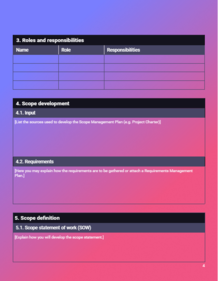
2. Requirements management plan
Seeing as one of the six purposes of the scope management plan is to define how you will go about collecting requirements, it follows that the requirements management plan is one of the main outputs of the scope management plan.
Confusing as it might sound, it actually makes your life easier. It means that, once you’re finished with the scope management plan, you already have two of the thirteen main PMP elements ready to go.
The requirements are set by the key stakeholders, which means that the PM must go around conducting surveys and interviews with stakeholders to collect the requirements. This is often an exhausting process that requires the PM to elicit information from the stakeholders.
Requirements fall under two main categories:
- Conditions, i.e. constraints (budget, cost, schedule, compliance, etc.)
- Capabilities, i.e. product description (size, build, color, etc.)
Oftentimes, the stakeholders will have a clear idea of the conditions for the project, but they won’t actually know what it is they want in terms of the product capabilities. In this case, it is also the PM’s job to help the stakeholders define their desired result.
The requirements management plan is what describes:
- How the PM will go about gathering all the information,
- How the requirements will be documented,
- How they will be managed,
- How they will be analyzed, and
- How the intended deliverables will meet all the requirements.
Properly collecting requirements is the first step toward project completion. The process is the backbone of several other plans and if done superficially it often leads to the collapse of the project. According to PMI’s report, as much as 47% of projects that fail do so precisely because of poor requirements management.
🔽 Download the Requirements Management Plan Template
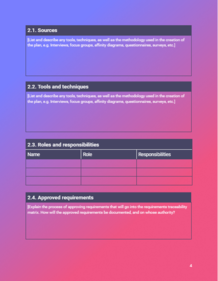
3. Schedule management plan
The main purpose of the schedule management plan is to define:
- How the project schedule will be developed,
- How the schedule will be monitored, and
- How any changes to the schedule will be handled.
Other elements that may be defined in the document include:
- The tools that will be used for scheduling,
- The measurement units that will be used,
- The process of updating and recording the project’s progress within the schedule,
- The amount of allowed deviation from the schedule baseline,
- The frequency and style of the reports, etc.
An important thing to note is that the schedule management plan does not contain the schedule itself. It is, as the name suggests, only a plan on how the schedule will be created, monitored, controlled, and executed. The same goes for all the other plans listed in this article.
🔽 Download the Schedule Management Plan Template
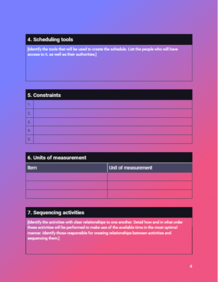
4. Cost management plan
The cost management plan is where you will define:
- How you will create the budget for the project,
- How you will approach planning the budget, and
- How any potential budget issues that emerge will be controlled.
The cost management plan may define the following:
- All the measurement units that will be used,
- How much the cost estimates will be rounded up or down,
- The allowed variation from the approved cost baseline,
- The frequency of the cost reports,
- The procedure for accounting for changes in the exchange rates,
- Explanation of the strategic choices in funding, etc.
Oftentimes, the length and the success of a project hinge on the size of the budget the PM has at their disposal. This is why the ability to efficiently allocate and manage the budget is a crucial skill in project management.
The cost management plan is an important document that helps the project manager structure the budget planning process in an effective and efficient way. Depending on the PM’s level of experience, the size, and the complexity of the project, the cost management plan may be more or less detailed.
🔽 Download the Cost Management Plan Template
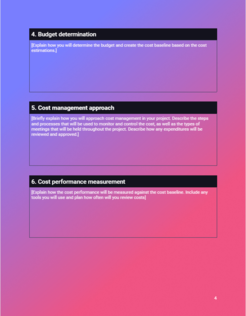
5. Quality management plan
The quality management plan concerns the policies and standards of quality set by the organization performing the project. It describes these policies and standards, and explains how your project will meet them.
Additionally, the plan must lay out a course of action should any quality-related problems with the end product arise in the future.
The quality management plan should be one of the first plans created in the planning phase as it influences other important decisions throughout the project planning process.
According to the PMBOK, the quality management plan typically includes:
- A description of the quality standards,
- Quality objectives,
- Quality roles and responsibilities,
- Any deliverables or processes that are subject to quality review,
- The means and procedures for quality control and management,
- Quality tools, and
- Other relevant procedures such as dealing with noncompliance and procedures for correcting and improving the product.
🔽 Download the Quality Management Plan Template
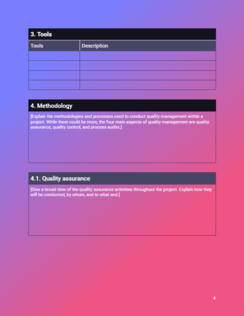
6. Resource management plan
Resources in project management refer to the following:
- Budget,
- Time,
- Tools, and
- People.
The resource management plan offers a detailed description of how the team resources and the physical resources of a project will be:
- Categorized,
- Allocated,
- Managed, and
- Released after the project is finished.
The resource management plan should explain:
- How the resources will be identified,
- How the resources will be acquired,
- How the inventory and supplies will be managed,
- How any changes in resource requirements will be handled,
- What the roles of the team resources are (e.g. business analyst, design engineer, project assistant, etc.),
- The level of authority of each of the team members,
- The duties and responsibilities of each team member,
- The skills the team needs to possess to finish the project within constraints,
- How the project team will be put together,
- How the team members will be instructed and trained,
- The reporting hierarchy, and
- Who is eligible for recognition or reward, how that reward will be given, and when.
🔽 Download the Resource Management Plan Template
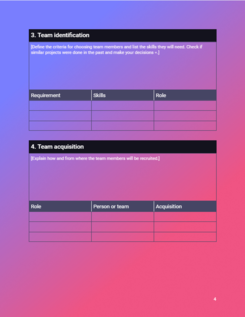
7. Communications management plan
The communication management plan maps out how all the communication regarding the project will be structured and conducted.
The communication management plan should describe the following:
- Stakeholder communication requirements,
- What information will be communicated to the stakeholders, in which language, format, and to what extent,
- Why the information will be communicated,
- How often it will be communicated,
- Who will be involved in the communication,
- What will be the means of communication,
- Who is responsible for the approval of the release of confidential information,
- What resources are available for communication,
- How will the communication management plan be changed in case the stakeholders change,
- Any constraints imposed by the company policies or state legislations, and
- How the information will flow during the project life cycle in the form of a flow chart.
🔽 Download the Communications Management Plan Template
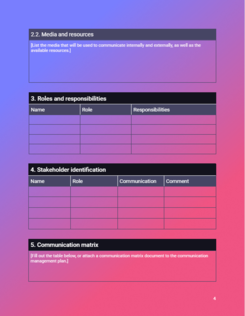
8. Risk management plan
Risk in project management refers to any unplanned event or situation that can happen during a project, that has either a negative or a positive impact on the project. The point of a risk management plan is to determine how to react when such an event occurs.
The risk management plan may define the following:
- Specific methodologies and tools that will be used,
- Who will be responsible for risk management and what their responsibilities will be,
- The budget available for risk management,
- How often will risk management processes be performed throughout the project,
- How risks will be grouped and categorized,
- How much risk are the stakeholders willing to take (stakeholder risk appetite),
- How risks should be categorized based on their impact on the timeline and budget,
- The probability of each individual risk happening (probability and impact matrix),
- How the findings of the risk management process will be presented and documented,
- A list of the possible risk that may occur during the project’s life cycle (risk register),
- How the behavior of the risks will be documented, and
- How the process of risk management will be audited.
🔽 Download the Risk Management Plan Template
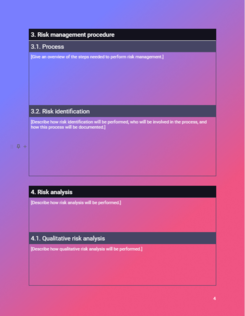
9. Procurement management plan
Unless a project is a small in-house project, chances are that you will need to deal with some kind of an external vendor or service provider. The procurement management plan outlines how you will deal with these external organizations.
The procurement management plan typically defines the following:
- How the procurements will fit the project budget and schedule,
- When the procurements will be needed and delivered,
- The way in which contracts will be managed,
- Roles and responsibilities of stakeholders,
- Possible constraints that could affect project procurement,
- Legal and budgetary aspects of procurement,
- Means to mitigate possible risk related to procurement, and
- A list of reliable external providers with whom you’ve worked before.
🔽 Download the Procurement Management Plan Template
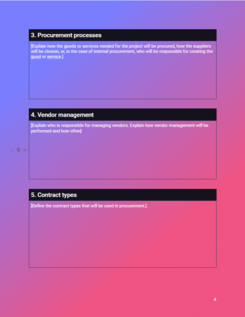
10. Stakeholder engagement plan
In theory, the simplest main element of the project management plan is the stakeholder engagement plan. It contains a list of strategies for how to include each individual stakeholder in the project and manage their expectations.
To create a stakeholder engagement plan, you need to understand the individual stakeholders’ interests, timetables, and agendas.
Not everyone needs to be included in every stage of the project, not everyone needs to be present at every meeting, and not everyone needs to receive equally detailed information. But everyone needs to be properly informed and engaged in decision-making throughout the project, and this requires a healthy dose of planning.
🔽 Download the Stakeholder Engagement Plan Template
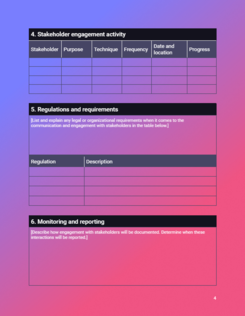
11. Project management plan constraints baselines
In addition to the ten main management plans, the project management plan must contain the three baselines:
- Scope baseline — the approved version of the project scope and it includes the project scope statement of work (SOW), the work breakdown structure (WBS), and the WBS dictionary.
- Cost baseline — the approved version of the project budget.
- Schedule baseline — the approved version of the project schedule.
As the three baselines have all been carefully planned, revised, and approved, they are used as benchmarks for determining a project’s success.
If the current project scope, budget, or schedule don’t match the expectations defined in the baselines, it means that the project is in danger of going off the rails.
💡 Plaky Pro Tip
If you want to learn more about project baselines, and why they are necessary in project management check out this guide:
What to do before writing a project management plan
It goes without saying that an ideal project management plan should contain all the elements described thus far. However, just as most projects are vastly different from each other, so too do project management plans differ from one to another.
Let’s take a look at how to create a good project management plan that fits your particular project.
Review pre-existing documentation
Before even thinking of creating a project management plan, you should first fully understand what it is that the client or sponsor wants you to do.
You should collect and carefully study all the already existing information related to the project (e.g. business case, feasibility study, contract, etc.) to give you a better idea about what your job will entail.
Another wise idea is to find precedents that you can analyze in order to try and replicate their successes and plan and prepare for some of the recurring problems.
Determine the scale of your project
Similarly to planning an argument in your head and then realizing that your opponent isn’t behaving as you had anticipated and that 90% of your clever comebacks are useless, projects won’t always flow the way you intended them to.
So, when it comes to smaller projects, spending too much time in the planning phase may be counterproductive, and end up wasting more time than it saves later on.
On the flip side, larger and more complex projects demand much more prep work. The longer the project, the greater the chance of scope creep, schedule or budget overrun, and eventual project failure.
Although some of the project management plan may still end up being less useful than you’d have thought, you’ll be glad of the time you invested in the preparations. As Dwight D. Eisenhower once said, “Plans are nothing, planning is everything.”
Just make sure you don’t fall into the trap of endlessly planning for failure and never starting the project in the first place.
Identify the stakeholders
Knowing exactly who has stakes in your projects, and who are the people who have a say in how the end product will look like is a third of the work.
Identifying the stakeholders is necessary for:
- Collecting requirements,
- Planning stakeholder engagement,
- Planning communication,
- Negotiating and acquiring the budget, and
- Knowing who has the authority to change and approve of the constraints, new features, and any changes to the project.
Create a rough outline of the project management plan
Before creating a project management plan you should create a rough outline of the plan. This is more or less the project charter — a broad image of the project at hand. The project charter will serve as a basis for the project management plan.
Get feedback
Once you have the broad strokes of the plan in place, you should ask your project team for feedback and additional input.
Two heads are better than one; ten can handle practically anything.
If you’ve overlooked something, picked out an inadequate approach, or can’t figure out how to fit the deliverables into the timeframe and budget you were allotted, chances are the collective mind of your team will be able to find an adequate solution.
But this is not the only reason to ask for additional input.
One of the most important skills for a project manager are people skills. A genuine interest in people and the ability to lead with confidence are what makes a good project manager.
Sharing the drafts with your team, asking for feedback and advice, and actually accepting it when it makes sense to do so builds trust and transparency within the team, as well as trust in you as a project manager.
If people trust you and like you, they are more inclined to follow you, do you a favor, or go the extra mile to help you finalize the project in the best way possible. So, establishing a trusting relationship and an open communication system with your project team, especially if you’ve never worked with them before, creates a solid foundation for executing the project.
Review your draft with key stakeholders
Once the final version of your draft is completed, it’s a good time to engage the stakeholders.
Running by them the finalized draft and getting their approval before moving on to the actual project management plan spares you the trouble of doing all that work to prepare a project management plan and then realizing that the stakeholders don’t agree with it.
How to make a project management plan
After doing all the necessary pre-planning, putting together the project management plan boils down to going through the list of the main subsidiary plans and baselines and composing them one at a time.
The easiest way to do this is to use pre-made templates which you will then adjust to your project as needed. The free templates we’ve prepared for you are all editable, so all you need to do is copy them to your Google Workspace and edit away, or use them as-is.
Once you have developed all the plans, it’s time to collect them into a single document that will be accessible to all team members and stakeholders.
How project management software helps turn your plans into action
Once all the planning is finished, the easiest way to bring everyone on the same page and kick off the project is to input the data into a project management app and watch the cogs start to turn.
Project management software helps teams coordinate work, keep track of their deadlines, and organize project milestones. Project management tools such as Plaky are a great way to visually present and manage everything, from your teams, and their tasks, to the progress of each individual and that of the project as a whole.
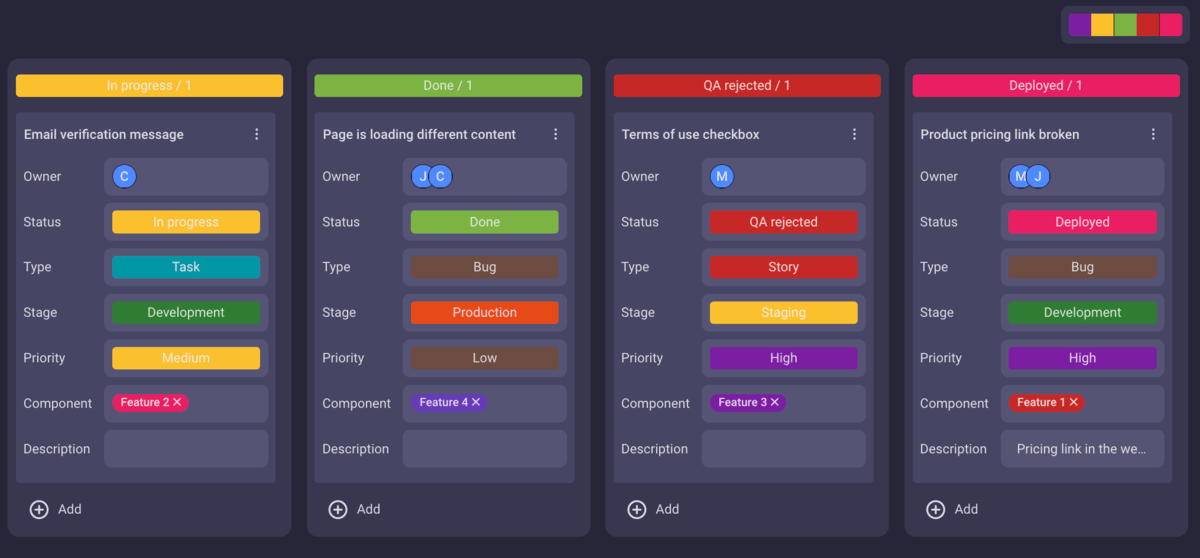
Cloud-based project management tools are also fantastic collaboration platforms, with the ability to comment, give feedback, and share files between people and teams. They have a plethora of different organizational methods teams can use to organize their subsidiary projects, such as Kanban boards, timelines, Gantt charts, velocity and burndown charts, and so much more.
Digital project management tools can be used in any type of a work environment, but it’s especially useful in remote organizations where managers need to have access to the employees’ work and progress, without the need for constant nagging and micromanaging.
Conclusion: PMPs are exhaustive guidebooks for managing projects
A project management plan is a comprehensive guide that details how every aspect of the project will be managed. It normally includes the three baselines and ten subsidiary plans, or more, depending on the type and size of the project.
Creating the project management plan is the responsibility of the project manager. The plan itself requires that some prep work is done in the initiation stages of the project.
Developing the plan normally takes several weeks of hard work, interviews, meetings, and constant revisions, but in the end, a comprehensive plan always pays its dividends.
The plan is consulted throughout the project and it allows PMs to dedicate their time and efforts where they’re needed, and, when necessary, solve problems by applying ready-made solutions they had already devised, instead of wasting time on solving them as they go.
📖 The project management plan is a useful organizational and planning tool. But, to pull it off well, a project manager needs working knowledge of many other project management areas. If you’d like to learn more about all the different project management areas of knowledge and the elements they’re composed of, explore our Project Management Glossary of Terms.
References
- Project Management Institute. (2021). A guide to the project management body of knowledge (7th ed.). Project Management Institute.
- Project Management Institute. (2018). Success in disruptive times: Expanding the value delivery Landscape to address the high cost of low performance. PMI. Retrieved February 2, 2022, from https://www.pmi.org/-/media/pmi/documents/public/pdf/learning/thought-leadership/pulse/pulse-of-the-profession-2018.pdf
- Project management Institute. (2014). Requirements management: A core competency for project and program success. PMI. Retrieved: February 3, 2022, from: https://www.pmi.org/-/media/pmi/documents/public/pdf/learning/thought-leadership/pulse/requirements-management.pdf
- Wellingtone. (2021). The State of Project Management. Wellingtone. https://wellingtone.co.uk/wp-content/uploads/2021/03/The-State-of-PM-2021.pdf
 Project Management Hub
Project Management Hub 











